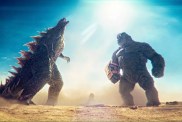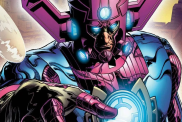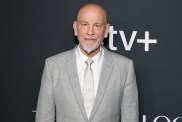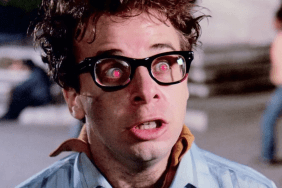What else is different about “Blade: Trinity?
One of the things is that some of Norrington’s offbeat humor in the first film, that humor appeals to me as well and there wasn’t as much of that in the second film, not to take anything away from Guillermo who’s a dear friend of mine. I felt it was something that we missed a little bit of in the second film, so that sort of dark, f**ked up sense of humor is in this movie. I think in a weird way, I thought the first one would be a little edgier in different ways and this film goes back to that. The one thing I was disappointed with and it was in the scripts for both movies was I didn’t feel there was actually much suspense or there were many actual real scares. There were a couple in the movies, so I was determined to craft some really suspenseful sequences. So there’s four or five that are just good old fashioned suspense. Everybody jumps in the first Blade film when the vampire played by Donal Logue is all crispy in the hospital, then he comes back. That’s a great moment, but we’ve got about four of those in this movie where something just out of nowhere happens and I don’t know how it happened, because we mean’t to do that in the second film but we didn’t really get many of those moments and so I was determined & basically the opportunity that you have doing the third film and we also did it with the second film is you take everything thats good, you analyze everything that worked in the first two and then everything that didn’t work for whatever reason and hopefully you try to fix what didn’t work or to add what was missing. This film also is sexy in a way that the first film was as well. The second film was successful, but the thing that was missing was the human element because almost every character in the film were vampires, and it also occurred to me that there was not much biting going on, so there’s more biting and blood drinking. This film is very sexual in a lot of ways too. But I was proud of the fact that Blade II was very different in tone and palette from the first film, and this one had its own & I set out for it to be different as well. It’s definitely not a Norrington film. It’s definitely not a Guillermo film, and anybody that knows me will look at it and say this is definitely me. This has my kind of combination of humor and hopefully edginess.
Is it more comic book like?
I know more about comics than Norrington or Guillermo. I mean, Guillermo knows a lot, but I really & the challenge is not making it so internal that only comic book audiences get it. So I think we did a nice balance of & thats why I have him pull out the comic book. I think pulling out the comic book works for comic book fans because they say, Oh ho ho, its Tomb Of Dracula,but I think if you pull it out just for people that never read any comic books, my whole point is the Dracula myth has become so neutered that it’s a comic book, it’s a sitcom, that it’s this, that it’s that. When he says sitcom, he’s really talking about Buffy and Angel, whatever, and The Little Vampire and stuff like that. So I think a scene like that works because it shows even the audience at large thats how defanged, pun intended, vampires have become. And also one of the points in this movie is that that was intentional on the vampire’s part. They were perfectly happy to become merchandised, comic book and animated characters because people take them less seriously and until they’re ready to take over the world and they basically decide they’re not until they can become daywalkers, they’d rather be this sort of mythologized, franchised, merchandised thing, that is the vampires with the exception of Drake & my whole reasoning was because he’s the progenitors of the vampires, hes got some abilities that they dont have: being able to go out in sunlight and shape shift and I took that from the Stoker stuff. Actually, theres a scene where he talks about Bram Stoker and how Stoker basically gave him a lot of bad P.R. He sort of derisively refers to it as Stokers little fable. So he has new powers. The rest of the vampires don’t have new powers per se. We’ve not changed, but the way that they die and ash & even simple things, like in the first film, there was really only one layer when they ashed. In the second film, we had two layers where there was sort of ashing and then we built the skeleton underneath. But this one for all the ashings, theres four layers, so theres skin and then theres sort of two layers of organs and then there’s the skeleton, so there’s a lot more sort of interactivity. We’ve got slow motion ashings. For instance, theres a shot where Blade stakes a woman and then kicks her, and so she spins and as she’s ashing, she spins, so shes got kind of a dust devil. So theres a lot more interactivity in terms of like the way they go down and stuff like that. Or if a guy gets ashed & if he gets staked in the head, hell start to ash from the head first. There’s a scene where somebody gets staked in the head and then Blade kicks him in the head and sort of kicks his head off, but the rest of the bodys kind of still ashing. A, special effects have gotten more sophisticated, but B, it just occurred to me as we were watching the other movies, theres a lot more fun we could have in terms of the visual effects. One of the things why you didn’t see a ton of Wesley action is & I showed Abigail’s thing where we had four vampires ashing there, but there’s like three major action sequences with Wesley and the vampires where he’s ashing 30, 40, 50 vampires and its just too dry without it. Even I can barely stand to watch it right now. I can’t remember how many ashings there are, but there are over a hundred and we tried to make every single one have its own little story and fun.
Who was the stunt coordinator?
We had two. We had Clay Fontineau, who was Wesley’s stunt double in all three films. He stepped up and then Eddie Perez who’s a friend of mine who was stunt coordinator for League Of Extraordinary Gentlemen and was a stuntman on Blade I and Blade II, Eddie’s been sort of coming up, stepping up, doing a lot of T.V. shows. He did my little movie Zig Zag, and I recommended him to Norrington on League and even though the movie is sort of truncated and f**ked up, Eddie did a really good job on that. And our fight choreographer was a guy named Chuck Jeffries who worked on the first one. He worked on Spider-Man. He worked on a lot of stuff.
How much of you has gone into the Blade mythology?
Well, even for the first one, a lot of it was me. I mean, if you know from the comic books, when we started working on it, Blade didn’t even use a sword. He used mahogany daggers and things like that. He wasn’t really a samurai or anything like that, and Deacon Frost was literally a church deacon in the south. He looked kind of like Colonel Sanders and Blade wasn’t initially even a hybrid. He didn’t have to feed and all of that stuff, and Whistler didn’t exist either. The funny thing is, it took a while for the first Blade film to get made and Marvel decided they liked the Whistler character so much that they put it & when Blade guest starred on the Spider- Man cartoon, they put Whistler on the cartoon and the movie hadn’t come out yet and there was actually a legal thing between New Line and Marvel because New Line said, Hey, you guys don’t own that character. Goyer created that character. That’s why in the first movie, it says The characters of Blade and Deacon Frost Created By & because everything else was stuff that I had done, but I was the one that argued that Marv Wolfman and Gene Colan should have credit in the first place. Marvel wasn’t going to give them credit and I said, ‘Why dont you give them credit?’ and I got on the line with New Line’s business affairs and they said O.K., but then the funny thing is they said O.K., but then we got some call from Marv Wolfman’s people who said that just he should get credit, not Gene Colan and I was like, Come on! I was surprised by that, so I said, ‘F**k that!’ He’s going to get credit too.
Wesley loves the Blade movies because he gets to show off his martial arts skills. What’s your style of shooting martial arts?
I decided to do less wire fu in this film, and the reason was I just felt it’s just been done to death. I like a lot of people were disappointed in the Matrix sequels. Not only do I think the wire-fu itself has been done to death, because it shows up & I mean, I was watching Charmed last year and they had some of the characters in Charmed doing& we’ve just seen people run up walls & we’ve just seen them do it a million times. You know, when we first did it in 98, it was kind of new and fresh. The Matrix hadnt come out. And so I felt that’s been done to death. There were a lot of great visual effects in The Matrix sequels, but I felt particularly like the Agent Smith fights and stuff like that, it just seemed like a video game, like cut scenes from a video game, and I started to feel like visual effects in some degree have become so sophisticated that you do all these amazing shots that a regular camera could never do, but the problem is I think on a subtle level, it takes you out of it because it doesn’t feel as real because the cameras swirling around. And so I decided to do less of that and try to do more stuff practically. So in terms of the stunts, I mean, we have stunts that are augmented by CG but I dont think there’s a single stunt that is CG in the film, which is different than in Blade II. And I think some of those CG stuntman shots worked really well and some of them looked like rubber man and some of the bad stuff in Spider-Man, but I just made a decision. So my approach ended up being the same thing that Chris is doing on Batman, which is its much more old school compositing and using CG to blend shots but if weve got somebody jumping forty feet, we shot all the elements practically with real stuntmen. And some of them are very sophisticated composites that involve ten, even twenty elements, but the approach is much more Blade Runner in that regard where all the elements that we shot are real but well sort of use CG to meld them together. So in terms of the martial arts, I knew that Abigail and King had to have different fighting styles than Blade. They had to have their own unique fighting style, and King and Abigail have a different style from each other. And what we would do is we started working on that with the fight choreographer and the stunt choreographers, developing their own style and then what we would do & you know, the fight choreographer would come up with ideas, videotape them with stunt people, and we developed a system where I would say, ‘Shoot them on a rehearsal stage, shoot the fight scenes north, south, east and west,’ which just meant set up the video camera on all four directions and show me what you propose and then my D.P. and I would look at the videotapes, criticize, say, I don’t like this beat. Let’s do more beats here,and then use that to guide how we were going to shoot it. Oh, that’s a really cool moment, so lets get the crane for that. And then what we would do is eventually we developed & this is how we would shoot it. We would shoot two wide masters or master setups, because Gabby and I used a sh*tload of cameras. We never shot with less than four, even for dramatic scenes and all the action we shot was seven or eight or nine cameras. So what I mean by master is, we would shoot the fight scene from this side with seven or eight cameras, everything but the kitchen sink, and then wed shoot it from that side with seven or eight cameras and then he and I would look at playback for like an hour and then decide, O.K., lets bring in the technocrane for this moment. Now let’s go in for this insert. And if it were ashings, we did most of the ashings with motion control and once again, motion control is so time consuming that we literally brought in five motion control rigs and crews and we would shoot with five motion control rigs at the same time so that we could get the ashing from five different angles in motion control, so it was crazy. So we would do that, and then we would leave and move on and we would leave second unit. Second unit would do cleanup, and their cleanup involved if there were wire pulls, since wire pulls are really time consuming. And by wire pull, I meant if somebody punches somebody and they fall, they fly back twenty feet. Usually second unit would clean up the wire pull and then they would clean up any inserts that we needed. So we would make a list as we went along. O.K., the sword goes into his side. Second unit will do that.
How many days of shooting?
We shot 87 days main unit and 41 days second unit. And second unit was usually running along a day or two behind us doing cleanup and so we would move & at one point, we had four different stages going and we would schedule it so we would rotate over to this stage and then second unit would come behind us and clean it up and I would bop back and forth as they would set up shots.

This is all in Vancouver?
This is all in Vancouver.
Did anyone at Marvel say anything about you working on the Batman movie?
Yeah, they did. You know, originally they wanted me to do Nick Fury at DreamWorks and then the whole Batman thing happened and I called Avi and I said, Listen, they’ve offered me Batman and I said, Ever since I was a little kid, I told my mom I wanted to go to Hollywood one day and do a Batman movie. I said, I gotta do it, and Avi said, No, you have to do it. You have to do it. They were totally O.K. with it.
Was it a leap of faith that Ryan Reynolds could bulk up and handle the role?
I trust my judgment in casting, and I knew he could pull off the humor and so he came in and he did an audition. He was really funny and then we had a long talk. We went out for a couple of beers and we talked about & because he’s a spaz, like physically a spaz. Like his first & and he’ll tell you the same thing. His first sort of rehearsal with the choreographers was kind of a disaster, because he’s a spaz but he learned and he was super committed. And I said as long as you’re really committed and willing to do it and before I finally pulled the trigger on it, I had him meet with the trainers, the physical trainers and said, What do you think? Do you think you can turn him into a superhero? Do you think his body can take it? Do you think he’s got the mindset to do this kind of G.I. Joe training? And they said, Yeah, he totally does. I should have shown you his fight scene with Triple H. He fights Triple H in the movie and he’s amazing, like really amazing. And it’s not just a little namby pamby fight. It goes on for like five minutes. He’s really good in it.
Who oversaw their training and what specialties did they train in?
The two stunt choreographers, Eddie Perez and Clay Fontineau, were involved and Chuck Jeffries was the fight choreographer, then they had a trainer and dietician here in L.A., the names I happen to forget, because they were here for about six weeks, and then they & this is Jessie, Ryan and Dominic Purcell, then they had a trainer and dietician in Vancouver that were a boyfriend/girlfriend team. The woman had also done Jessica Alba on Dark Angel, had trained her, not to fight but to get physically in shape. They were on this brutal regimen. They had to eat something every two hours, and particularly Ryan and Jess were just religious about it. I haven’t even shown you the big third act stuff. The little bit that you saw with Jess is times eight like in the third act in terms of what she’s doing. Like that shot where she flips up, that’s her. There was nothing that wasn’t her in what you saw, but like I said, she does much more extensive moves and fights than what you saw.
Were there injuries on the set?
None of our stars got injured. Our first day, a stuntman went through a glass window and then fell and sliced open his wrist on the glass and then he was running up the stairs and the camera is shooting down and you see blood spurting out. It’ll be on the DVD. It actually hits the camera lens, and this was our first day and I thought, Were so f**ked, because that was so minor compared to & we destroyed $170,000 worth of glass in the movie. That was so minor compared to the stuff that we had still to do. So that happened, and like little six stitch cuts and things like that, but nothing significant.
It seems like there are a lot of pyrotechnics in this film.
Well, that was another thing. We didnt have many pyrotechnics in the other movies and I just thought, Lets blow some sh*t up! It’s fun! And there’s more big stuff that you didn’t see. And I also thought if you’re going to have the feds come in and sort of f**k up Blade and Whistler’s place, they got to really f**k it up in a big apocalyptic way. Those guys were really good. They had done X-Men and I Robot. They’re Canadian and they did a great job. Every time you would say, I want it this big, they would make it a little bit bigger. That’s what pyrotechnic guys are always like. I would say, I want a ten foot wide fireball, and we would do it and it would be a 20 foot wide fireball. Like that night, when we blew up that place, that was Halloween night and after it happened, well, first of, nobody could hear because it was so loud and Clay, who’s Wesleys stunt double, from one of the concussive blasts was knocked back about thirty feet into the air and he was wearing padding and stuff but I thought we were f**ked. He was knocked like ten feet into the air and lands on his back and was stunned for a minute and then got up. That was one of those things where the pyrotechnic guys said, Oh yeah, we decided to make it a little bigger. So Clay was fine and Did all the cameras get it? Yes,and everybody was like, Holy sh*t, that was big.









